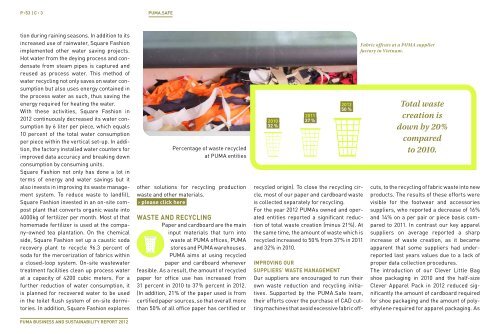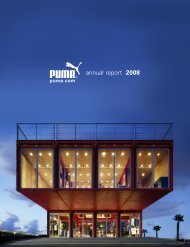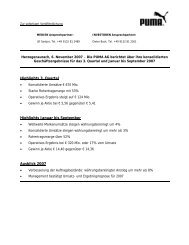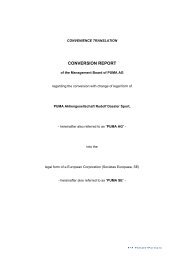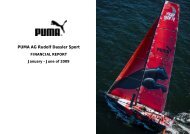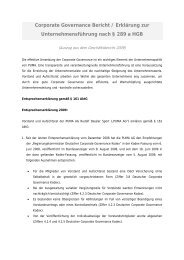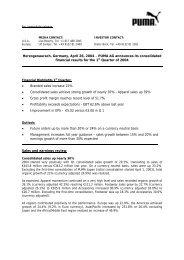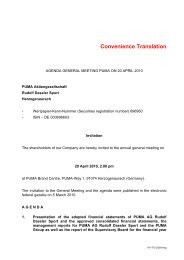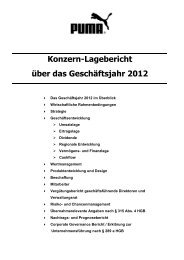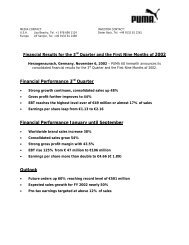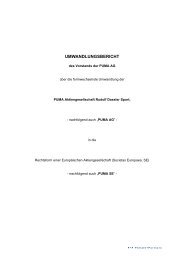Html - PUMA CATch up
Html - PUMA CATch up
Html - PUMA CATch up
Create successful ePaper yourself
Turn your PDF publications into a flip-book with our unique Google optimized e-Paper software.
p : 53 | c : 3 <strong>PUMA</strong>.SAfe<br />
tion during raining seasons. In addition to its<br />
increased use of rainwater, Square Fashion<br />
implemented other water saving projects.<br />
Hot water from the deying process and condensate<br />
from steam pipes is captured and<br />
reused as process water. This method of<br />
water recycling not only saves on water consumption<br />
but also uses energy contained in<br />
the process water as such, thus saving the<br />
energy required for heating the water.<br />
With these activities, Square Fashion in<br />
2012 continuously decreased its water consumption<br />
by 6 liter per piece, which equals<br />
10 percent of the total water consumption<br />
per piece within the vertical set-<strong>up</strong>. In addition,<br />
the factory installed water counters for<br />
improved data accuracy and breaking down<br />
consumption by consuming units.<br />
Square Fashion not only has done a lot in<br />
terms of energy and water savings but it<br />
also invests in improving its waste management<br />
system. To reduce waste to landfill,<br />
Square Fashion invested in an on-site compost<br />
plant that converts organic waste into<br />
4000kg of fertilizer per month. Most of that<br />
homemade fertilizer is used at the company-owned<br />
tea plantation. On the chemical<br />
side, Square Fashion set <strong>up</strong> a caustic soda<br />
recovery plant to recycle 96.3 percent of<br />
soda for the mercerization of fabrics within<br />
a closed-loop system. On-site wastewater<br />
treatment facilities clean <strong>up</strong> process water<br />
at a capacity of 4200 cubic meters. For a<br />
further reduction of water consumption, it<br />
is planned for recovered water to be used<br />
in the toilet flush system of on-site dormitories.<br />
In addition, Square Fashion explores<br />
<strong>PUMA</strong> BUSineSS And SUStAinABility RePoRt 2012<br />
Percentage of waste recycled<br />
at <strong>PUMA</strong> entities<br />
other solutions for recycling production<br />
waste and other materials.<br />
› please click here<br />
wasTe and recycling<br />
Paper and cardboard are the main<br />
input materials that turn into<br />
waste at <strong>PUMA</strong> offices, <strong>PUMA</strong><br />
stores and <strong>PUMA</strong> warehouses.<br />
<strong>PUMA</strong> aims at using recycled<br />
paper and cardboard whenever<br />
feasible. As a result, the amount of recycled<br />
paper for office use has increased from<br />
31 percent in 2010 to 37 % percent in 2012.<br />
(In addition, 21 % of the paper used is from<br />
certified paper sources, so that overall more<br />
than 50 % of all office paper has certified or<br />
2010.<br />
32 %.<br />
2011.<br />
37 %.<br />
2012.<br />
50 %.<br />
recycled origin). To close the recycling circle,<br />
most of our paper and cardboard waste<br />
is collected separately for recycling.<br />
For the year 2012 <strong>PUMA</strong>s owned and operated<br />
entities reported a significant reduction<br />
of total waste creation (minus 21 %). At<br />
the same time, the amount of waste which is<br />
recycled increased to 50 % from 37 % in 2011<br />
and 32 % in 2010.<br />
improving our<br />
s<strong>up</strong>pliers’ wasTe managemenT<br />
Our s<strong>up</strong>pliers are encouraged to run their<br />
own waste reduction and recycling initiatives.<br />
S<strong>up</strong>ported by the <strong>PUMA</strong>.Safe team,<br />
their efforts cover the purchase of CAD cutting<br />
machines that avoid excessive fabric off-<br />
Fabric offcuts at a <strong>PUMA</strong> s<strong>up</strong>plier<br />
factory in Vietnam.<br />
Total waste<br />
creation is<br />
down by 20 %<br />
compared<br />
to 2010.<br />
cuts, to the recycling of fabric waste into new<br />
products. The results of these efforts were<br />
visible for the footwear and accessories<br />
s<strong>up</strong>pliers, who reported a decrease of 16 %<br />
and 14 % on a per pair or piece basis compared<br />
to 2011. In contrast our key apparel<br />
s<strong>up</strong>pliers on average reported a sharp<br />
increase of waste creation, as it became<br />
apparent that some s<strong>up</strong>pliers had underreported<br />
last years values due to a lack of<br />
proper data collection procedures.<br />
The introduction of our Clever Little Bag<br />
shoe packaging in 2010 and the half-size<br />
Clever Apparel Pack in 2012 reduced significantly<br />
the amount of cardboard required<br />
for shoe packaging and the amount of polyethylene<br />
required for apparel packaging. As


